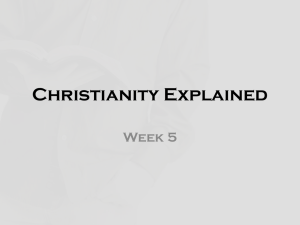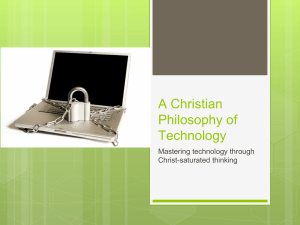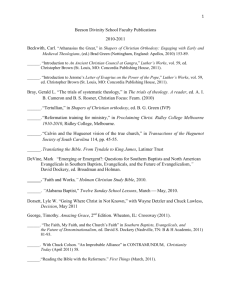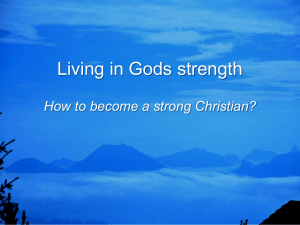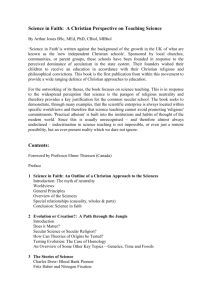“The cycle of Life, Death and afterlife in Judaism, Christianity and
advertisement
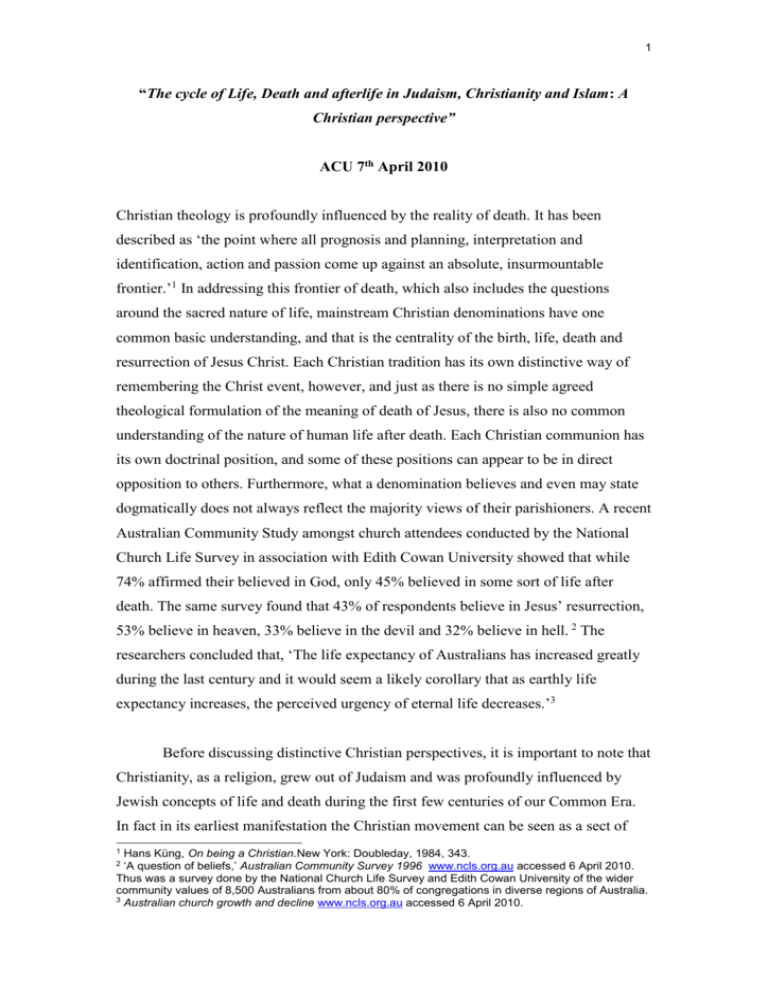
1 “The cycle of Life, Death and afterlife in Judaism, Christianity and Islam: A Christian perspective” ACU 7th April 2010 Christian theology is profoundly influenced by the reality of death. It has been described as ‘the point where all prognosis and planning, interpretation and identification, action and passion come up against an absolute, insurmountable frontier.’1 In addressing this frontier of death, which also includes the questions around the sacred nature of life, mainstream Christian denominations have one common basic understanding, and that is the centrality of the birth, life, death and resurrection of Jesus Christ. Each Christian tradition has its own distinctive way of remembering the Christ event, however, and just as there is no simple agreed theological formulation of the meaning of death of Jesus, there is also no common understanding of the nature of human life after death. Each Christian communion has its own doctrinal position, and some of these positions can appear to be in direct opposition to others. Furthermore, what a denomination believes and even may state dogmatically does not always reflect the majority views of their parishioners. A recent Australian Community Study amongst church attendees conducted by the National Church Life Survey in association with Edith Cowan University showed that while 74% affirmed their believed in God, only 45% believed in some sort of life after death. The same survey found that 43% of respondents believe in Jesus’ resurrection, 53% believe in heaven, 33% believe in the devil and 32% believe in hell. 2 The researchers concluded that, ‘The life expectancy of Australians has increased greatly during the last century and it would seem a likely corollary that as earthly life expectancy increases, the perceived urgency of eternal life decreases.’3 Before discussing distinctive Christian perspectives, it is important to note that Christianity, as a religion, grew out of Judaism and was profoundly influenced by Jewish concepts of life and death during the first few centuries of our Common Era. In fact in its earliest manifestation the Christian movement can be seen as a sect of 1 Hans Küng, On being a Christian.New York: Doubleday, 1984, 343. ‘A question of beliefs,’ Australian Community Survey 1996 www.ncls.org.au accessed 6 April 2010. Thus was a survey done by the National Church Life Survey and Edith Cowan University of the wider community values of 8,500 Australians from about 80% of congregations in diverse regions of Australia. 3 Australian church growth and decline www.ncls.org.au accessed 6 April 2010. 2 2 Judaism,4 but with some of its expressions being influenced also by Egyptian and Greco-Roman cultic understandings.5 For instance, the Aristotelian idea that weak, disabled people ‘should be killed at an early age’ is confronted directly by stories of Jesus compassionate healing of those who suffered and struggled.6 Such narrative language in the Christian Scriptures facilitated appropriate communication about issues of life and death not only with those of a Jewish background, but with Gentiles also. As a consequence it reinforced group compliance and helped to maintain continuity in the face of fluid social, political and religious circumstances, especially when these faith communities were small and vulnerable to change. 7 Many of these understandings have continued to be retained in the global Christian community and this paper will explore three broad Christian presuppositions about the cycle of life, death and after-life that are held by today’s followers of Jesus. The first approach sees the after-life being the primary purpose for appropriate living in this life; the second presupposition is that death is a point of transition between this life and the next; and the third position is that this life is all that is. 1. The afterlife is the primary purpose of being in this life. The earliest Christian Church was founded at a time when a flat earth was assumed with heavens above where God, angels and the Saints dwelt while beneath the earth was an underworld, known as Hell or Hades, and ruled by antagonistic entities. These ancient understandings provide a context for reading the teachings of Jesus in the Christian Gospels. The early centuries of the Common Era was also a time when imperial persecution and suffering was inflicted on those who were being perceived to give priority to the Lordship of Christ over the Emperor. As a consequence there was always comfort and hope in the concept of an after-life where the faithful who suffered in this life are rewarded in heaven, and where mothers and babies who died during birth or soon after would go to a safe and nurturing place in the presence of God and the angels. Metamorphosis, or transition between life and death, was an unquestioned given and was important in terms of individual honour, communal identity, and sometimes affirmation of a particular ethnicity under persecution. The 4 Küng, On being a Christian, 344. Lorenzen, 257. 6 Nan Hill, ‘Helping the handicapped,’ Journal of the Christian Medical Fellowship 34, 1 (1988) 4-6. 7 Turid Karlsen Seim, and Jorunn Økland (eds.) Metamorphoses: Resurrection, Body and Transformative Practices in Early Christianity. Berlin: de Gruyter, 2009. 5 3 dominant understanding was that compliant holy and good people went to heaven while the unholy, sinful individual, after appropriate judgment, would be condemned to an afterlife of never-ending torture in hell or to one of temporary arrest with the hope of vindication and ultimate welcome into a new dimension of being that would last forever.8 It is not necessarily a division between religious and non-religious, however. In fact, the Christian Scriptures are quoted as justifying the divine preference for some Christians over others. To support this perspective, the saying of Jesus recorded in Matthew’s Gospel is frequently cited: ‘Not everyone who says to me, “Lord, Lord,” will enter the kingdom of heaven, but only the one who does the will of my Father in heaven. On that day many will say to me “Lord, Lord, did we not prophesy in your name and do many deeds of power in your name?” Then I will declare to them, “I never knew you; go away from me you evil doers”.’9 The rise in fundamentalist movements within Western Christianity over the past century has resulted in an increasing emphasis on the prime purpose of life being a time of temporary testing before the more important after-life. Largely dependent on the apocalyptic sayings of Jesus and the Book of Revelation, this life is seen as providing the opportunity for a person to enter successfully into a more important everlasting life that will overcome death in a heavenly realm. In this scenario, death is seen as the moment of transition between the temporary now and the eternal then, with a well-documented personal faith commitment being the guarantee of entry into a heavenly realm where visible engagement with God occurs and reunion with past friends and relatives will be experienced. Baptism is seen as an essential sacrament providing the opportunity for a public confession of sin that is then followed by a statement of forgiveness from an appropriately appointed apostolic leader. For some Christians holding this view, the proof of true faith involves a commitment to the active conversion of others, in order lovingly to save them from the perceived inevitable judgment of hellfire and brimstone. Australian theologian, Val Webb, describes these kinds of understanding as offering ‘certainty through unquestionable unchanging truth. They also offer for people in times of change a close fellowship, held together by allegiance to common truths. They are attractive to those who feel 8 The Egyptian Book of the Dead. Or, The Papyrus of Ani. (trans.) F. A. Wallis Budge www.forgottenbooks.org, 20. accessed 3 March 2010 9 Matthew 7:21-23 and Luke 6:46; 13:25-27 4 alienated from society.’10 It is a theological stance that continues to have significant social, political and religious impact. Heaven is ‘above’ and heavenly beings ‘look down’ upon those on earth following their every move, hearing their prayers, keeping records of their faith adherence. However, Daniel Migliore, a Professor of Systematic Theology at Princton University points out that this ‘traditional theology . . . has often counselled the poor to accept their lot as ordained by God.’11 It is also a theological framework that tends to dismiss modern cosmological concepts, rejecting evolutionary understandings and diminishing the validity of environmental challenges on the basis that concern for this damaged earth is unnecessary when this earth will be replaced by New Heavens and a New Earth at the Second Coming of Christ who will bring ultimate judgment on all who have chosen to live their lives outside of that salvific framework. Death, then, is to be rejoiced in as the beginning of a more significant life in the hereafter for the Christian believer. But it is also a devastating experience for a parent, sibling or close friend who dies without having embraced Christian faith in this way. 2. Death is the transition between this life and another Widely accepted is a less literal and more symbolic Christian understanding of death. It is one that sees spiritual and ethical profundity in the Scriptural statements about Christ’s return, the resurrection of the dead, the last judgment, the promise of eternal life and the danger of eternal death.12 This kind of understanding recognises that an element of mystery surrounds the concept of an after-life, but also ‘brings to our activities and struggles in this life the passionate expectation of all-encompassing renewal.’13 The Catholic theologian Hans Küng, reflects this position noting that, It is clear that the blue firmament can no longer be understood, as in biblical times, as the external side of God’s presence chamber. But it can certainly be understood as the visible symbol or image for the real heaven, the invisible domain (living space) of God. The heaven of faith is not the heaven of the astronauts. . . It is not a place, but a mode of being: not one beyond the earth’s confines, but bringing all to perfection in God and giving a share in the reign of God.14 10 Val Webb, In defense of doubt. An invitation to adventure. St Louis MS: Chalice Press, 1995, 30. Daniel L. Migliore, Faith seeking understanding. An introduction to Christian theology. Grand Rapids MI: Eerdmans, 1991, 116, citing John Calvin, Institutes of Christian religion 1.16.6. 12 Migliore, Faith seeking understanding, 247. 13 Migliore, Faith seeking understanding, 247. 14 Küng, On being a Christian, 352. 11 5 The Anglican funeral liturgy reflects the relational elements of this concept. It speaks of disposing ‘reverently of the mortal body’ but at the same time recognises that ‘those who die in Christ share eternal life with him.’ To ‘die in Christ’ is predicated on the belief that ‘Christ is risen, that those who believe in him will rise with him, and that we are united with them in him.’15 The Roman Catholic Liturgical Commission, similarly, recognises that ‘Death, whether expected or unexpected, brings grief and disorientation. The death of a Christian, however, calls the faith community to proclaim in hope and trust that, because of the saving death and resurrection of Jesus, life is changed, not ended.’16 John Donne, the famous poet, who was also a 15th century Dean of St Paul’s Cathedral London, suffered an early death probably from the Plague or Typhus. He exemplifies this theological position of hope, stating in his final sermon: Our last day is our first day; our Saturday is our Sunday; our eve is our holy day; our sunsetting is our morning; the day of our death is the first day of our eternal life. The next day after that . . . comes the day that shall show me to myself. Here I never saw myself, but I shall see God too . . . Here I have one faculty enlightened, and another left in darkness; mine understanding sometimes cleared, my will at the same time perverted. There I shall be all light of joy, and my body in the light of glory.17 This understanding is predicated on the belief that resurrection recognises that ‘the life of God is stronger than the estranging power of death’ and that ‘the resurrection of Jesus means the ultimate death of death.’18 For Karl Barth, it is to be seen as ‘God’s Yes!’ to the prayerful request of Jesus’ on the cross, ‘Father forgive them because they do not know what they are doing.’ 19 It is an understanding that Dying is not something to be dreaded, but can be the beginning of a new mystical security birthed in faith and hope. 3. This life is all that is important In the late 19th century Ludwig Feuerbach wrote The Essence of Christianity in which he argued that the idea of God arises from human experience, that God is the longing 15 Australian Prayer Book. Sydney NSW: General Synod of the Church of England of Australia, 1978, 583. 16 www.litcom.net.au/liturgy_lines/displayarticle.php?llid=289 accessed 31 March 2010. 17 John Donne, Sermons, cited by Philip Yancey, Soul survivor. How my faith survived the church. London: Hodder & Stoughton, 2003, 213. 18 Thorwald Lorenzen, Resurrection and discipleship. Interpretive models, biblical reflections, theological consequences. Maryknoll NY: Orbis, 1995, 257. 19 Luke 23:34. Karl Barth, Evangelical theology. An introduction. Edinburgh: T & T. Clark,1963, 154. 6 of the human soul personified and that the doctrine of the resurrection of Christ is an echo of the deep human longing for immediate certainty of personal immortality.20 This third way of thinking about death has gained more momentum over the past century as increasing concepts based on individualism and rationalism are influencing human thought. It perceives the thought contained in the previous two understandings as dualistic and prefers a framework of understanding that provides a continuity, or ‘process,’ between and among all that exists.21 It is not necessarily an atheistic concept as the New Testament Gospels are consulted frequently for the ‘verbal constructs’ of Jesus they offer. That means Jesus can ‘be discovered, recognised, identified, and apprehended in circumstances subsequent to Calvary’ as a meaningful and inspiring component of ordinary everyday of life.22 It is an understanding that God is present, immediately and intimately, in the here and now. Furthermore, it perceives the entire world as ‘the body of God,’23 a world that continues and thrives on the continuity of all life cycles- agricultural, animal and human. Death is seen as a final personal human experience and after the ‘final breath’ there will be no further experiential moment except amongst those who both grieve their loss and at the same time rejoice in the inspiration of a life well-lived. The meaning of that life is affirmed as their travelling companions continue the active participation with God’s search for social justice, along with the love-filled sharing of life with family, friends and the wider community. At death the baton is passed on to others who have been influenced along the way and that Easter-flavoured baton, as Michael McGirr stated in last Saturday’s Melbourne Age, ‘points to a life too big to live on our own terms.’24 Conclusion We have looked at three broad Christian understandings of death, dying and after-life. For some Christians the whole of life is a focus upon death; constant living with ‘one 20 Ludwig Feuerbach, The essence of Christianity. 2nd ed. George Elliot (trans) Charlston SC: Bibliobazaar, 1999. Originally written in 1841 and published in German. 21 See Robert B. Mellert What is process theology? An introduction to the philosophy of Alfred North Whitehead and how it is being applied to Christian thought today. New York: Paulist Press, 1975. 22 Marianne Sawicki Seeing the Lord. Resurrection and early Christian practices. Minneapolis MN: Fortress Press, 1994, 8. 23 Sally McFague, The body of God.An ecological theology. Minneapolis MN: Fortress, 1993. 24 Michael McGirr ‘Light in dark places,’ The Age. Easter edition. April 2-3, 2010, 15. 7 eye on eternity.’25 For other Christians, death is the transition point of eternal living where earthly life is transformed into an ‘eternity already in their hearts.’26 Then for some other Christians the whole direction of human life is a ‘being toward death,’27 it is about the ‘travelling towards rather than the arriving.’ 28 Christian theology offers many pathways to think about death and dying. With the majority of church attendees ageing rapidly, funerals in traditional Christian churches and funeral homes will be frequent occasions for conscious reflection on the meaning of life, even though many of those participating will be people who may no longer identify with a particular Christian affiliation.29 In fact, recent research shows that it is not in traditional places like churches or cemeteries that people find the most spiritual comfort after a death. Rather, mourners prefer to gather around the actual spaces where people lived and died, placing flowers at roadside accident sites, or fixing memorial art installations and memorial plants in the family home. They are extremely conscious of the mystery that surrounds birth, life and death, and their capacity to find deeper wells of meaning and to mature physically, psychologically, emotionally and spiritually will continue to challenge an appropriate Christian response from today’s Christian church.30 25 David Winter, Hereafter. A new look at an old question: What happens after death? London: Hodder &Stoughton / SPCK, 1972, 14. 26 Winter, Hereafter, 90. 27 Marianne Sawicki Seeing the Lord. Resurrection and early Christian practices. Minneapolis MN: Fortress Press, 1994, 335. Citing Martin Heidegger, Being and time. John Macquarrie and Edward Robinson (trans.) New York: Harper & Row, 1962. 28 Charles Birch and John B. Cobb Jr, The liberation of life: From the cell to the community. Cambridge: Cambridge University Press, 1984, 109. 29 John Bellamy and Keith Castle, 2001 church attendance estimates. NCLS Occasional Paper 3. Februrary 2004. www.ncls.com.au accessed 6 April 2010.’ The age profile of each denomination provides the strongest indication of future trends. It is now unlikely that the large mainstream denominations, with their older age profiles, will be able to replace the large percentages of attenders who will inevitably be lost to death or infirmity in the coming years.’ 30 Catherine Cook and Philip Hughes, ‘Youth spirituality: How young people change,’ Pointers 16, 3 (2006) www.cra.org.au accessed 6 April 2010.

